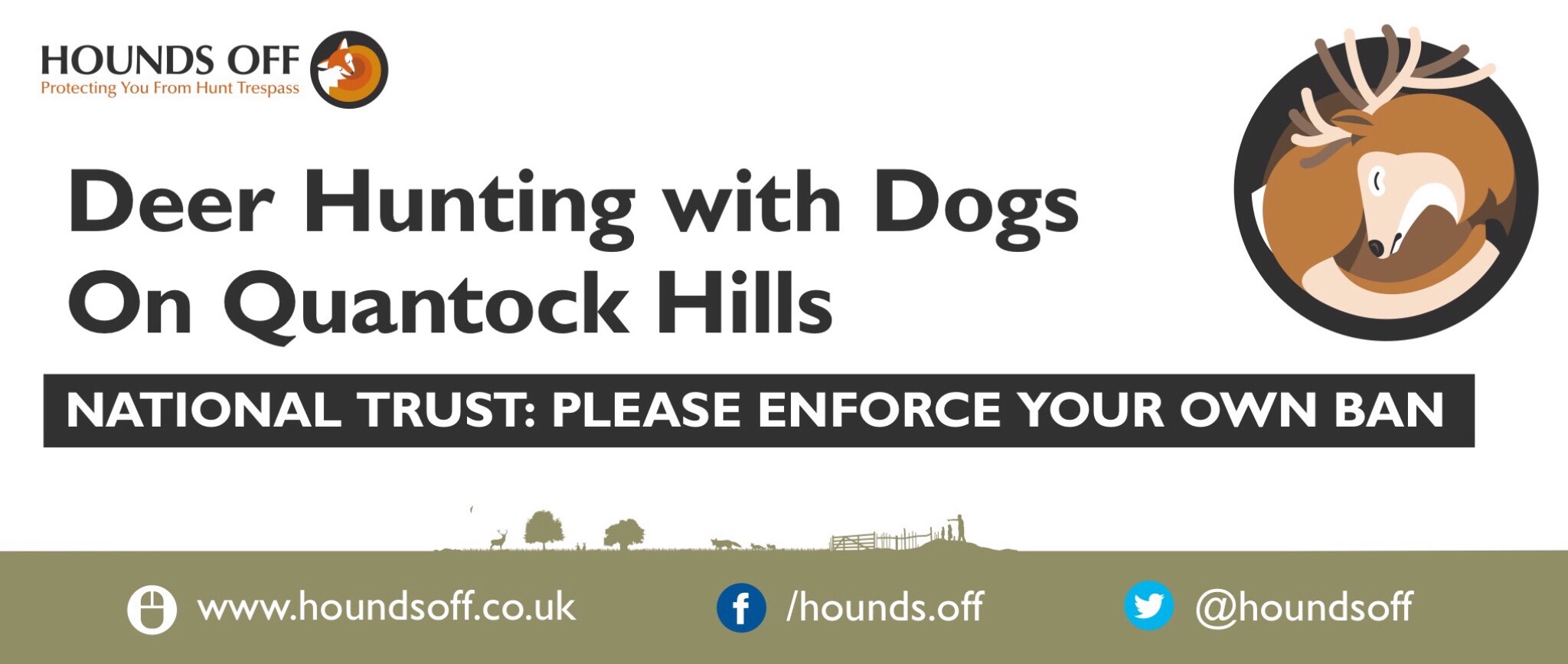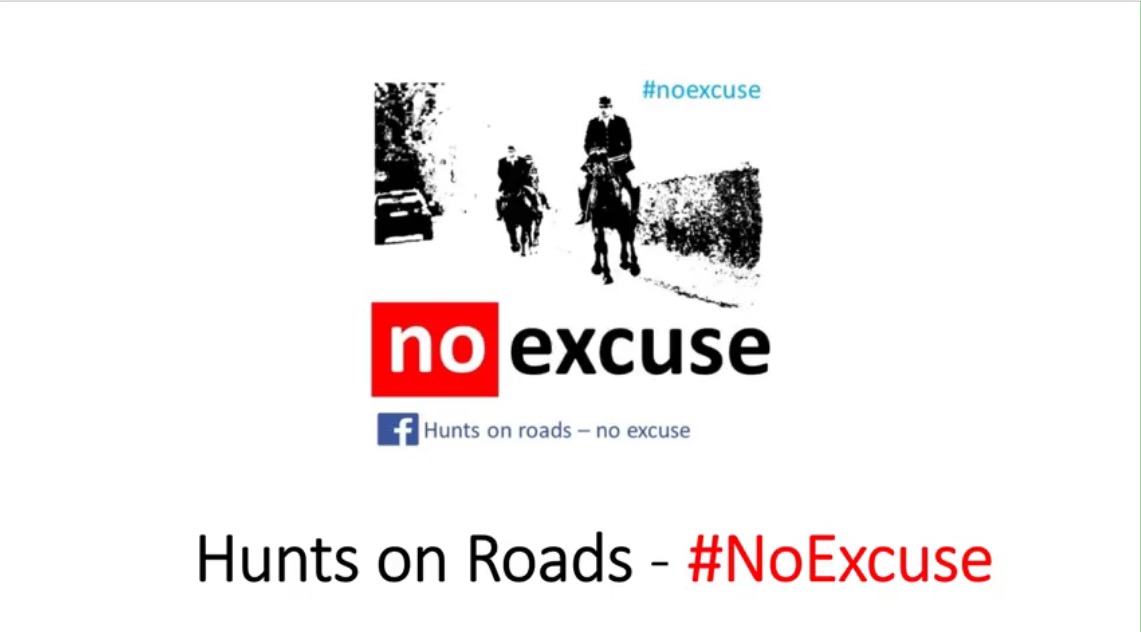29th September 2018
Kent Wildlife Trust - Hunting For The Truth
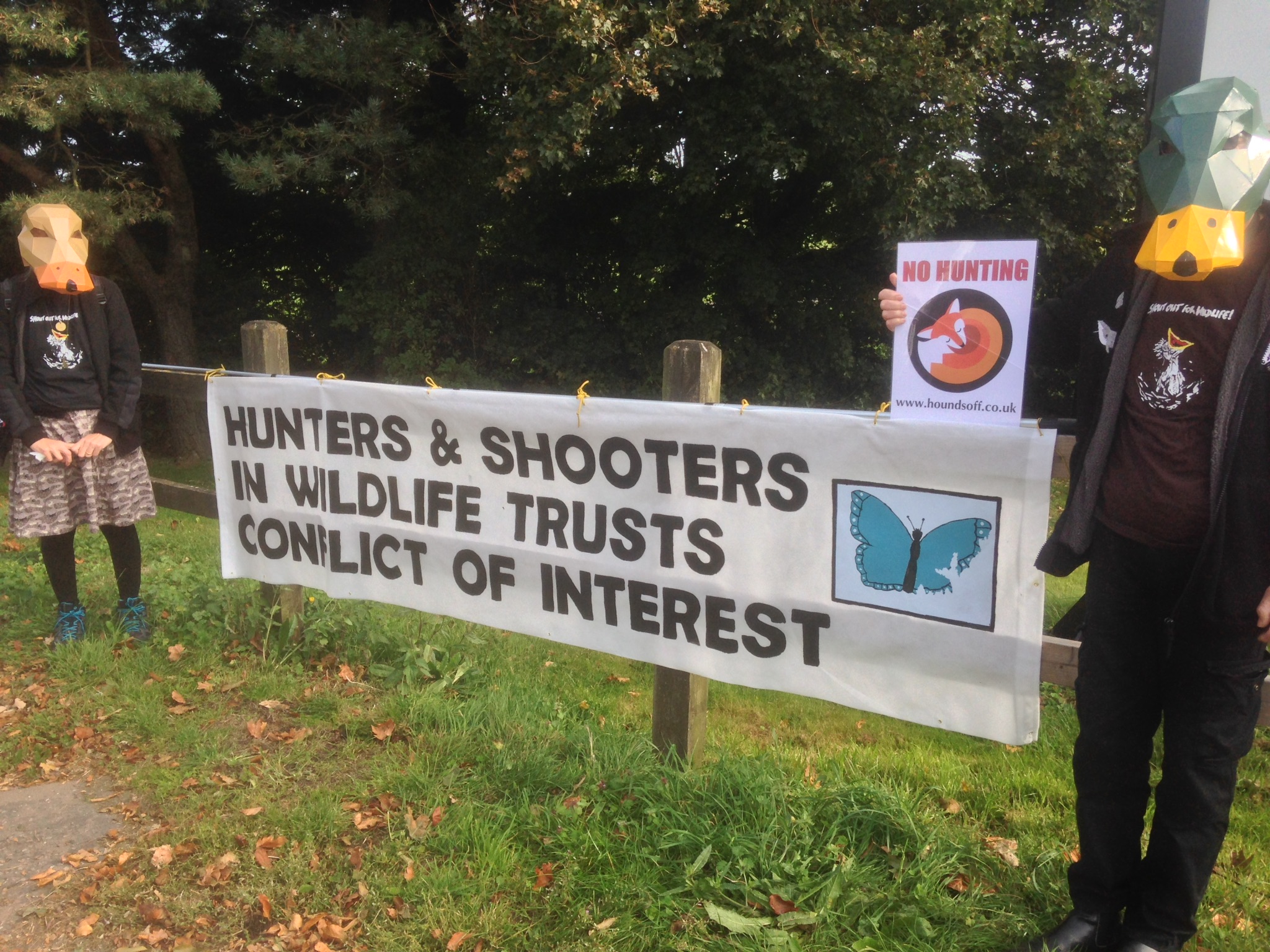 Demonstrators at the Kent Wildlife Trust 2018 AGM, highlighting the fact that serious questions about their Chairman and his hunting connections remain in dispute.
Demonstrators at the Kent Wildlife Trust 2018 AGM, highlighting the fact that serious questions about their Chairman and his hunting connections remain in dispute.
At the Kent Wildlife Trust 2018 AGM, held at the Kent County Showground, Detling, on September 29th, Hounds Off Founder Joe Hashman spoke on behalf of over 205,000 people who have signed Tom Fitton’s petition calling for the pro-hunting Chairman to be replaced. Here is what he said:
Some people are not telling the truth about the Kent Wildlife Trust Chairman and his involvement with hare hunting. The truth matters because it cuts to the heart of who controls the countryside.
Kent Wildlife Trust accept that their current Chairman, Mike Bax, hunted hares with the Blean Beagles only until thirteen years ago, when this pastime was prohibited.
But our evidence shows that he was the Huntsman for the Blean Beagles from 1971 until ‘91 and from then until 2016 he was a Joint Master.
For twenty years, as Huntsman his job would have been to help his dogs seek and destroy hares for the amusement of paying spectators. As Joint Master, his responsibilities would have included the day-to-day running of the Hunt.
Beagling is a deliberately cruel bloodsport. The greater the suffering, the better the hunting. Beagles are finely tuned killing machines, selectively bred to run slower than a sprint-specialist hare but with enhanced stamina and sensitive noses so they can follow the scent that their quarry leaves behind as she tries to escape.
There is no natural predator that hunts hares like this. Beagling is the complete opposite of natural selection.
Beagles work as a pack under the guidance of a Huntsman. Their aim is to gradually tire the hare enough for the dogs to pull her down and bite her to death.
In favourable conditions and the right mood to chase and catch a hare, beagles are relentless. 90-minutes from find to kill is considered perfect (1). At the bloody end, the Huntsman and spectators will have been marvellously entertained, their quarry reduced to a stiff-legged, hunched, shattered shadow of her former self and the beagles will relish their hard-earned prize.
But don’t just take my word for it. Listen to what was being written in the sporting press shortly before beaglers took their activities underground to avoid falling foul of the law.
From the Purbeck & Bovingdon Beagles in Dorset; “… we had a splendid morning with a hunt of three hours finally killing in a field of kale.” (2)
From the Stoke Hill in Devon; “An entertaining day….A useful view of the hare running the road … saw hounds on good terms again … a final fast burst across some old pasture saw this well beaten hare accounted for … A hunt of over two hours …” (3)
“A useful view” means that the hare had given hounds the slip but someone saw it and told the Huntsman where. “Well beaten” means stiff-legged, hunched and shattered. “Accounted for” is a euphemism for catching and ripping apart.
From Somerset, the Clifton Foot bragged, “… a classic hare hunt … recorded a successful conclusion in three hours and twenty six minutes.” (4)
This from the Chilmark, also in Somerset; “The best of November hunting … the field had a grandstand view of an eighty minute hunt … they ran into the hare at the fields feet.” (5)
In beagling, spectators are known collectively as ‘the field’. So, translated, this means the dogs killed the hare right in front of everybody who was watching.
In the Home Counties, the South Herts gushed; “Better was to come … where visitors …. saw hounds catch their hare after a glorious seventy minutes of steady hunting.” (6)
The Cambridgeshire-based Pipewell Foot boasted, “An amazing hunt was enjoyed … for nearly one and a half hours … to a well-deserved conclusion.” (7)
The North Staffordshire Moorland wrote of one hunt climax, “The view … was magnificent as they rolled her over in an open meadow below.” (8)
“Rolled her over.” Sounds almost pleasant doesn’t it? But we’re not talking about making love in the clover. It’s a rose-tinted euphemism for glossing over the cruel reality of using dogs to chase a hare to the limit of her physical ability, then savage and rip her to pieces.
This from the Holme Valley, in Yorkshire; “…a hare was hunted for around for 70 minutes giving the remaining field some excellent viewing until hounds were rewarded in the copse.” (9)
Nobody thinks about how the hare feels do they? It’s all about the glorious view and the sweet little dogs who deserve a prize at the end of all their hard work. In fact, people who go beagling are actually advised not to consider the suffering of the hare and are warned that if they do then their enjoyment might be spoiled (10). I wonder if Mike Bax ever considered the plight of his quarry during twenty years as Huntsman and another twenty-five as a Master?
This from the Pevensey Marsh, just down the road in Sussex;
“The day from Little Marshfoot was probably the best of the season … killed at dusk, after ninety minutes.” (11)
And, bringing it right back home, during the season before the ban the Kent Wildlife Trust Chairman Mike Bax’s own Blean Beagles killed 22 hares and boasted in the sporting press of “producing some fine sport”. This included “accounting for a tired hare” after a “very fast” half-hour, and catching another after a continuous chase over two and a half miles (12).
Parliament banned beagling in 2005 because it seriously compromises the welfare of the hare (13) but the abuse didn’t stop. Many hunts pretended they were chasing a scent laid by a human runner. They called this newly invented fictitious activity “trail hunting”, but trail hunting is a con. It’s a false alibi designed provide a cover for illegal hunting.
Others pretended to be after rabbits because rabbits are not protected by the law.
Shortly after beagling was banned, one of the Countryside Alliance’s own national board members, the late Admiral Sir James Eberle, boasted, “a previously not well known breed of ‘bush rabbit’ provided a notable quarry.” The Countryside Alliance’s man was clearly and defiantly sticking two fingers up at the Hunting Act because there is no such creature as a ‘bush rabbit’ (14).
As I said earlier, not everyone is telling the truth.
Scratch the surface, read between the lines, take the trouble to inform yourself even slightly. Only the corrupt or wilfully ignorant could fail to see that, between the bloodsports community and Countryside Alliance, there is a nationwide criminal conspiracy to subvert the law and carry on cruel and illegal hunting.
This is awkward for the Kent Wildlife Trust. Mike Bax is part of the Kentish bloodsports community and his apparent addiction to killing for fun is clearly at odds with their aims and objectives.
As well as heading up the Wildlife Trust, former Huntsman and Hunt Master Mike Bax is an ex High Sherriff of Kent, sits as Chairman of the Kent Rural Crime Advisory Group and is President of Kent Crimestoppers. So what is really going on here?
For many years the hunting lobby has been infiltrating the system by getting their people into positions of authority. It’s a tactic called Entryism.
We believe that Mike Bax is part of this tactic. That’s not to say that everything he does is bad. He will be party to decisions and policies on which we all agree. This is all part of the smokescreen and, amid the fog, clearly Mike Bax swings his power and influence to open doors which Kent Wildlife Trust find so irresistible that they feel compelled to push misinformation about their Chairman to cover their backs.
This is actually about vested interests and criminal elements presenting an acceptable face to facilitate the abuse and killing of animals in beautiful surroundings. Their ultimate goal is to repeal the Hunting Act, then embed hunting into the fabric of society so that the public and Parliament never challenge its existence again.
Our campaign is not an attack on Kent Wildlife Trust, its employees, volunteers or members. We recognise and support what they do in terms of worthy work to restore, save and enhance our natural heritage. But, and it’s a big “but”, we have a wealth of evidence regarding the links between Kent Wildlife Trust, their Chairman Mike Bax and the Blean Beagles hare hunt which contradict their official statements.
In the absence of any explanations which stand up to proper scrutiny, it seems perfectly reasonable to continue to politely ask their Chairman to step aside.
As I said at the beginning, not everyone is telling the truth.
© Joe Hashman
(1) Horse & Hound, 07.11.1980
(2) Hounds Magazine, November 1990
(3) Hounds Magazine, December 1990
(4) Hounds Magazine, October 1987
(5) Hounds Magazine, April 1990
(6) Hounds Magazine, November 1990
(7) Hounds Magazine, Summer 1990
(8) Hounds Magazine, April 1990
(9) Hounds Magazine, Volume 4 Number 1
(10) The Art Of Beagling. Captain J. Otho Paget. Pub. H.F. & G. Witherby. 1931. Page 217
(11) Hounds Magazine, April 1990
(12) Hounds Magazine, Summer 2004
(13) Lord Burns Enquiry Into Hunting With Dogs, June 2000. Point 6.67
(14) Baily’s Hunting Directory 2006-2007, page xivi
At the Kent Wildlife Trust AGM held in Chatham on September 23rd 2016, Hounds Off Founder Joe Hashman spoke on behalf of 156,000 people who signed a petition calling for the Chairman to stand down. Read or listen here.
Sign Tom Fitton’s petition here.
Support Hounds Off.
12th September 2018
Your Membership & Voice Matters #Bateson
Since 1988 there have been five National Trust (NT) Members Resolutions against hunting with hounds. Some were defeated, others were carried. Way back in 1990, the Chairman used between 30 and 40 thousand proxy votes in an attempt to defeat two motions presented to the AGM. It only half worked because one, the Cronin-Wilson Resolution (to ban staghunting on NT land), was carried by 68,679 to 63,985.
That Members voted to stop this particularly hideous form of rural entertainment rocked the NT Ruling Council and the hunting community at large.
The Ruling Council ignored the Members. Instead of implementing a ban, they set up a Working Party crammed with hunting sympathisers to investigate the implications of a ban whilst specifically ignoring the abuse of and suffering caused by deer hunting with dogs. Predicatably, the Working Party recommended no ban on staghunting. The hunting fraternity, amid threats of rural vandalism and disobedience if the bloodsport was prohibited, urged their supporters to join the NT in an effort to swing the balance of power in their favour. There was a battle royal being waged within and around the NT.
Lord Soper was President of the League Against Cruel Sports at the time and also a member of the NT. His Members Resolution to a NT Extraordinary General Meeting held on Saturday 16 July 1994 (The Soper Resolution) called for a “balanced Working Party to be convened to consider the aspects of cruelty and welfare that were ignored previously.” It was carried by a whopping 114,857 to 99,607.
In April 1995 the NT Ruling Council invited Professor Patrick Bateson of Cambridge University to conduct a two-year scientific study into the welfare implications of hunting deer with hounds. He and his team did this with the full co-operation of West Country staghunts and the League Against Cruel Sports. The findings were published as ‘The Behavioural and Physiological Effects of Culling Red Deer’ (aka The Bateson Report). The evidence of cruelty inherent in staghunting and the proven effects of suffering caused to hunted deer, regardless of whether they were eventually killed or not, stunned all concerned. The day after being presented with The Bateson Report, the NT Ruling Council (to its credit) agreed not to renew any licences for staghunting on NT land.
After a couple of days shame and shock, the hunters fought back. Among other tactics, Countryside Alliance President and staghunting apologist Baroness Mallalieu set up Friends of the National Trust (FONT) with the aim of getting their people elected onto the NT Ruling Council and overturning the staghunting ban. Even now in 2018, FONT has not fully succeeded, but under the disguise of pro hunting organisations and individuals they are still trying.
You Membership matters and your voice counts!
© Hounds Off
2nd September 2018
Hunts On Roads - #NoExcuse
One of the most extraordinary photos Surrey Hunt Monitors has taken is of Morestead Road, near Winchester. It’s an unremarkable road, but at about 2.15pm on Saturday 27 January 2018 it looked like a canine racetrack.
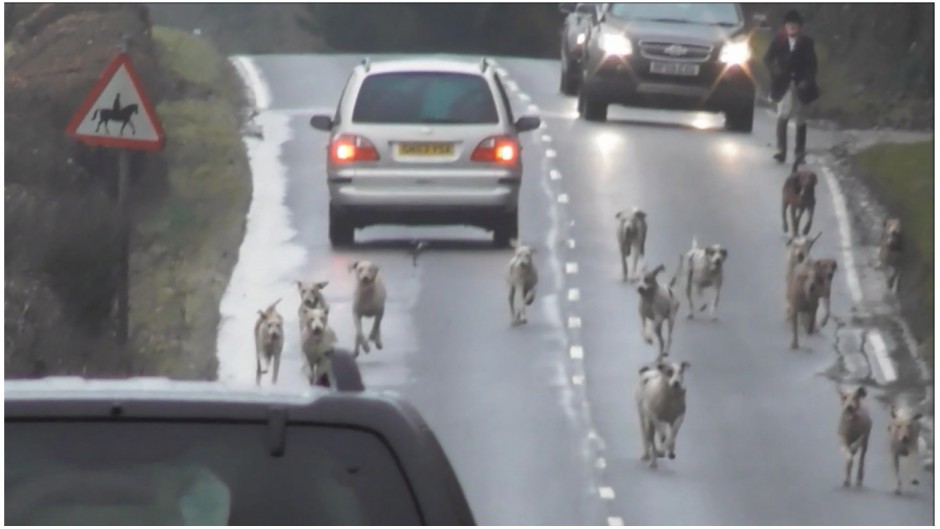
Funny old place to lay a trail. It would be almost as stupid as on the A1(M) motorway in North Yorkshire (28 January 2017), or through a cat sanctuary in Kent (9 January 2018).
Of course it wasn’t actually the case that a trail was laid in any of these places. In each case the hounds had been following animal scents. In the Morestead Road case, the scent was of two deer which had been chased by the hounds and had crossed the road a short while before.
What happened next was referred to on Twitter as #HuntHavoc. It’s a very appropriate term. It risks lives, not just of the animals being chased and the hounds doing the chasing, but also the people driving on the roads who, at any moment can find themselves in the wrong place at the wrong time, like the driver of this car who had to make an emergency stop and swerve to avoid one of the Morestead Road hounds as it emerged from the undergrowth along the side of the road and into his path:
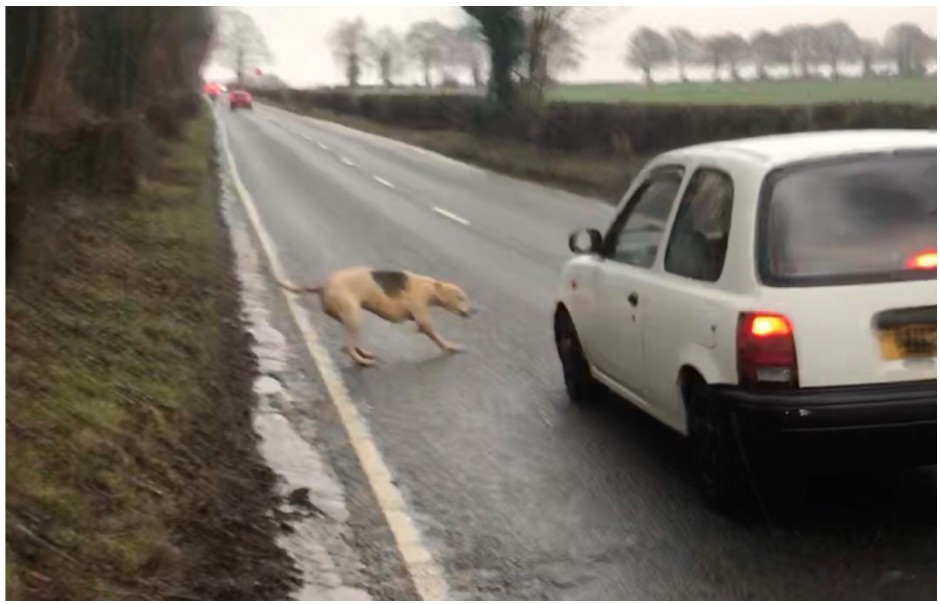
For a video of this on Twitter see here.
A driver cannot help his or her instincts. See a dog run out in front of you, and you will do as he did and swerve as well as brake. If a car had been coming the other way, a very nasty collision could well have occurred.
So whose fault would it have been? Not the driver’s, but the owner of the hound. And that’s because dogs on roads are inherently dangerous that the Road Traffic Act 1988 contains a provision - Section 27, subsection (1) - which makes it a criminal offence to cause or permit a dog to be on a road without the dog being held on a lead.
So isn’t it obvious then, that the owners of hounds which go on roads are committing an offence? Actually, no. As with all legal issues connected with hunting, its not so simple as that. The hunting lobby had powerful friends in Parliament when this Act was passed and they ensured an exception for hunts. It reads: “subsection (1) … does not apply to dogs proved … to have been at the material time in use under proper control for sporting purposes”. Hence it is perfectly legal, whilst out hunting, for a pack of well-behaved hounds to trot along a country lane with the hunt in the classic picture-postcard image hunts like to portray.
But the key words for this purpose are “under proper control”. In what possible sense is a hound under proper control if it is on a public road chasing a fox or deer? In the Morestead Road case, it was such a clear cut situation that the local (Hampshire) police investigated and interviewed the relevant hunt, the Hursley Hambledon Hunt. The matter appears to be nearly resolved with a Community Resolution Order, meaning that the hunt accepts responsibility and writes a letter of apology. Whilst not a conviction, it is a step on that road (if the pun will be forgiven) and the Hursley Hambledon Hunt will have to be much more careful in this coming season, since the next offence would likely mean a caution, and the one after that a court appearance.
The “squeeze”
However, there can be other cases where it is arguably not so clear. The hounds may not be on the road for so long, for example, with the hunt arguing the hounds were in fact under control. This is when what lawyers like to call a “squeeze” can be brought into play.
Consider a case where a hunt is accused of unlawful hunting under Section 1 of the Hunting Act 2004. The defence is invariably of “accident”: the hounds were following a trail when they just happened to come across a fox and chased it. The recent Grove and Rufford and Portman Hunt cases are just two examples. Hounds could not be called back (despite best efforts, of course). Or the huntsman was not sufficiently close to the hounds to be in control and hence responsible. But if the huntsman was not close enough to control his hounds, or was close, but not able to control them, and they cross a road, the Section 27 offence surely cannot be avoided: there is a “squeeze” between the two offences. In order to escape the Hunting Act offence, the hunt is inescapably admitting (indeed positively claiming) a lack of control and hence the commission of an offence under the Road Traffic Act.
Hound exercise
Another activity undertaken by hunts is “hound exercise”. This is in principle an unobjectionable behaviour in as far as the hounds are simply taken out for a run. If only hunting were replaced entirely by hound exercise! However, hounds need exercise every day and it must be a significant effort to put them in a van and drive them to somewhere safe to get this. Hence it’s not surprising that some hunts use roads to access nearby fields.
The question is, does the hunting exemption then apply? The clear answer is “no”. To repeat, the relevant language of the defence is (emphasis added): “subsection (1) … does not apply to dogs proved … to have been at the material time in use under proper control for sporting purposes”. The fact the hounds are used three times a week for hunting is of no relevance to the other four days of the week. There is no blanket exemption for foxhounds. When hounds are being taken out for exercise and use a road they must, like any other dog, be on a lead, or else an offence under Section 27 of the Road Traffic Act will be committed.
Some hunts are worse again and do not even bother to take the hounds to a field. One example local to Surrey Hunt Monitors is the Hampshire Hunt. They’re based in a quiet village called Ropley and here one can often see the entire pack being led around the village roads by three cyclists causing chaos:
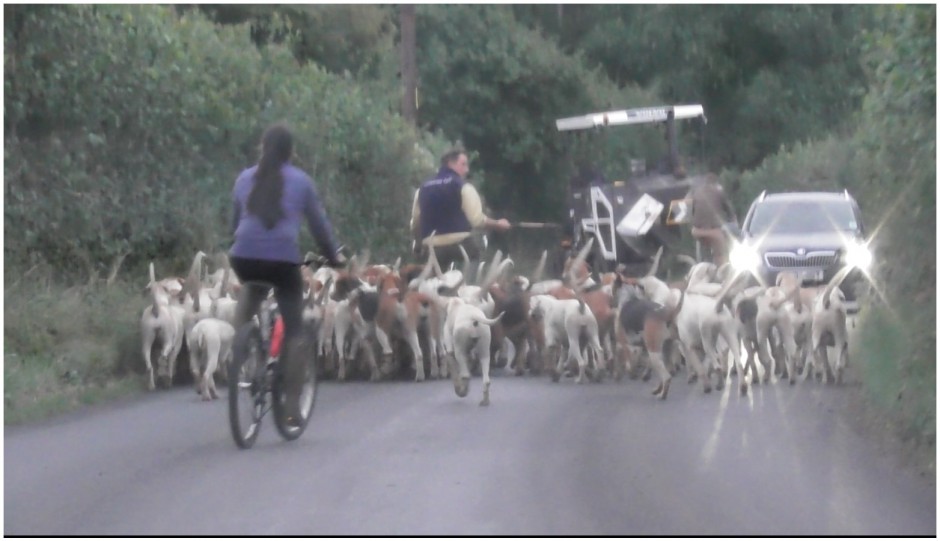
… not to mention depositing a large amount of dog mess …
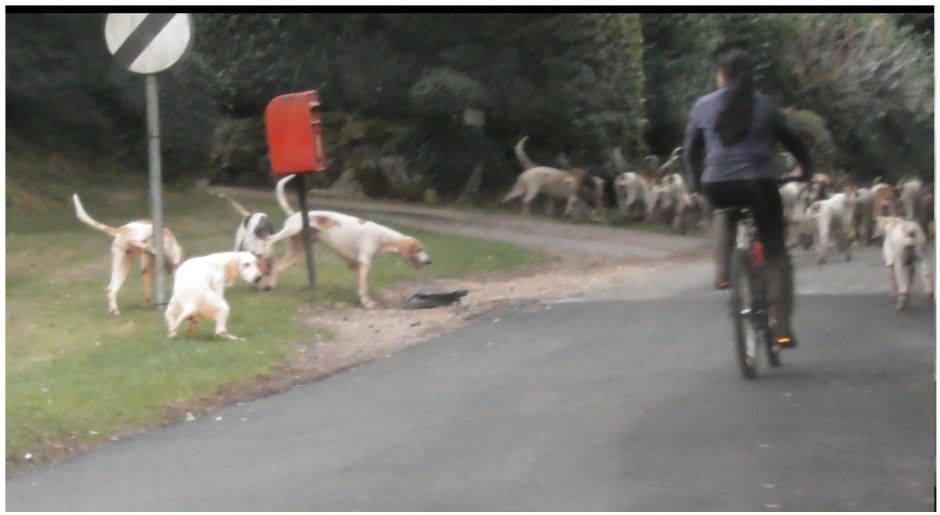
Two sample incidents have recently been reported to Hampshire police, and we await hearing from them as to if and how they intend to proceed.
Advice for Campaigners and the Public
Convictions under the Road Traffic Act are distinctly second best to Hunting Act convictions, but given the difficulty of the latter, they represent a way forward in controlling the reckless behaviour of hunts. So we offer two bits of advice;
1. If you are out early one morning hoping to catch your local hunt cubbing and only see them exercising their hounds on the local roads, dial 101 and report them under S.27 Road Traffic Act 1988. If the police say hunts are exempt, put them straight.
2. On hunt days, when hunt hounds cross a road in pursuit of a fox or deer, report both illegal hunting and the RTA offence and the chances are the hunt will walk straight into the “squeeze”. Let’s at least stop #HuntHavoc before an innocent person is killed in addition to the thousands of innocent foxes who die every year in so-called trailhunting “accidents”. After all, there is #NoExcuse.
© A Surrey Hunt Monitor

